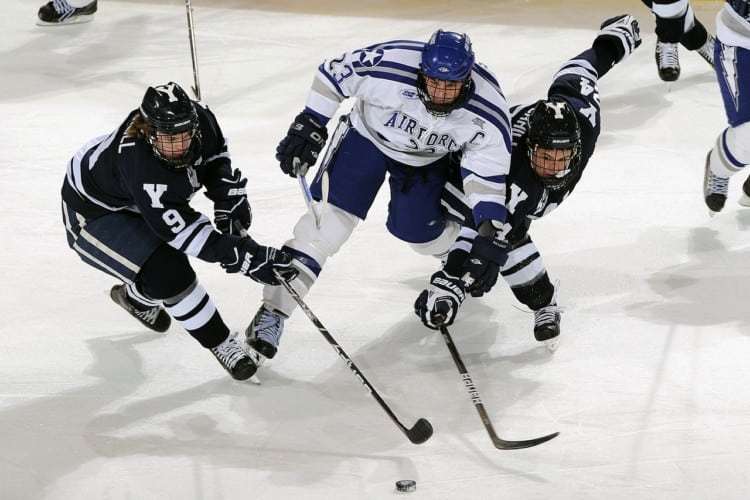
Real World Science: Hockey
October 19, 2017 - Emily Newton
Revolutionized is reader-supported. When you buy through links on our site, we may earn an affiliate commission. Learn more here.
Hockey season is just beginning. We all love the fast-paced sport and watching our favorite players speed around the ice as they chase the puck. It’s not a sport you would usually associate with science and math, but a lot more thought goes into the game than meets the eye. Follow along as we explore the science of hockey.
Skating — Newton’s Three Laws of Motion
Sir Isaac Newton’s three laws of motion apply whenever something is moving. It doesn’t matter if you’re just tossing a ball to a friend or sprinting across the ice of a hockey rink — these laws still apply. If you’re a bit rusty on your basic physics, the laws are as follows:
Law 1 — An object will either remain moving or remain at rest unless acted upon by another outside force. In many cases, those forces are things like air resistance and gravity.
Law 2 — That outside force mentioned in the first law changes in the momentum of the object over time. This can also help you determine the velocity of an object. Simply multiply the mass of the object by its acceleration to find the force.
Law 3 — For every action, there is an equal and opposite reaction. This is the law you’re probably the most familiar with, mostly because it’s used to describe everything from motion to behavior.
What do these laws have to do with the science of hockey?
It all comes back to force. Everything in a hockey game involves applying some form of force. Two players slam into each other on the ice? There’s force there. Launching the puck into the goal requires force. Even skating across the ice requires that same force, simply directed downward through the player’s skates.

Checking — Newton’s Second Law
Law No. 2, the law of momentum, applies to checking. By looking at that simple formula — mass times acceleration equals force — we can determine the amount of force being applied during a checking maneuver.
Let’s assume you’ve got two players moving in opposite directions on the ice. Player one is 175 pounds and is moving at 15 mph. Player two is 210 pounds and sprinting at 25 mph. It’s important to note that most of these calculations are normally done in metric units, but we’re trying to keep things simple here.
Player one will strike with approximately 54 kilos or 119 pounds of force, while player two with his larger size and faster speed will strike with 108 kilos or 238 pounds of force. Given the fact that the larger player’s force exceeds the smaller player’s weight, a check maneuver will be more successful if initiated by the larger player than the smaller one.
Now, we’re not always going to be able to accurately judge the speed of a player as he slides across the ice, and checks from smaller players moving faster can potentially be more effective than those from slow-moving large players. However, it gives you a good idea of the physics behind these players slamming into each other on the ice.
The sheer power of these strikes is why having a properly tested helmet and safety gear is essential. Sure, players are going to get hurt on the ice, but a high-quality helmet can mean the difference between a check resulting in a bloody nose or one that results in a fractured skull.

Saving — Geometry and Reaction Time
The job of the goalie is simple — they stay in the goal and keep the puck from reaching the net. It seems pretty straightforward, doesn’t it? You’d never guess that there is math — specifically, geometry — at work behind that goalie’s mask.
The hockey rink is basically one giant page of plane geometry — the study of flat objects like angles, triangles and other similar shapes. It’s all about angles when that puck is moving across the ice. A player uses vectors to determine how to shoot the puck so it reaches a teammate who is also moving across the ice at high speeds. They use geometry to pass the puck off the boards behind the goalie, and the person sitting in the goal has to use the same geometry to predict where the puck will be coming from and how best to deflect it.
The latter relies heavily on reaction time — a fast snapshot from a player can often push the puck to speeds of over 100 mph, so split-second reaction times are necessary to respond to those speeds and make the correct movements to block the puck. The fastest slapshot ever clocked was made by Zdeno Chara, who moved the puck at a whopping 108.8 mph at a skills completion in 2012.

Shooting — Projectile Motion
Shooting a hockey puck across the ice isn’t about slapping it as hard as you can with the stick. The science of hockey involves aim, control, precision and speed. Slapshots may be all about power and speed, but a wrist shot is all about precision and projectile motion.
As its name suggests, projectile motion defines the movement of an object after it’s propelled into the air. A wrist shot launches the puck into the air while causing it to spin, so it remains stable as it flies.
While the puck is on the ice, it falls under that same plane geometry we mentioned a moment ago. When it takes flight, though, you have to consider gravity as well. A flying puck travels along a parabola, or a curved path. Essentially, it keeps going up until it no longer has the energy to fight gravity’s pull, so it starts to fall down toward the ice again.
Now, you can calculate the force exerted by the puck by using the same formula that we used to calculate the force of a check by various-sized players. With a little more math, you can calculate everything from how fast the puck will fall — Spoiler alert: The force of gravity near the earth’s surface causes everything to fall at 9.8 meters per second squared — to how far it would travel if the air resistance in the rink changed.

The Science of Hockey: Fast Ice vs. Slow Ice
We all know what ice is, but what is fast ice and slow ice when it comes to the science of hockey? If you’ve ever seen an ice skater or hockey player kick up snow with their skates, then you’ve seen slow ice. Also known as bad ice, the surface of the rink becomes rougher, which makes the puck bounce more. This usually happens toward the end of a period, after the players have been sprinting up and down the rink after the puck.
Fast ice, or good ice, is the smooth, hard ice that is on the rink at the beginning of the match, or after the Zamboni has been run across the rink between periods. Rinks in warm climates, even in indoor climate-controlled areas, are more prone to the creation of slow ice because of the constant melting and freezing of the ice.
Hockey is a fantastic pastime, but there is definitely more to it than just smacking a puck around.
Revolutionized is reader-supported. When you buy through links on our site, we may earn an affiliate commission. Learn more here.
Author
Emily Newton
Emily Newton is a technology and industrial journalist and the Editor in Chief of Revolutionized. She manages the sites publishing schedule, SEO optimization and content strategy. Emily enjoys writing and researching articles about how technology is changing every industry. When she isn't working, Emily enjoys playing video games or curling up with a good book.







